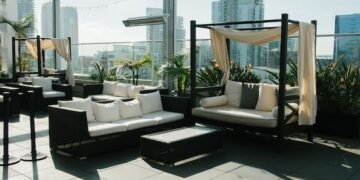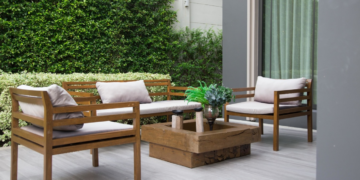Hardwood floors are one of the most elegant and popular flooring options. They drastically increase the home’s resale value and are believed to be a high-end flooring solution by the majority. Sure, they’re not on par with marble flooring, but the right hardwood type (like mahogany) can come close.
Still, the majority of homes won’t use mahogany floors. Instead, they’ll use:
- Oak
- Maple
- Cherry
- Walnut
- Ash
- Bamboo
Here are a few things you should know about these hardwood flooring types to help you choose the right one for your home.
1. Oak
Oak is incredibly durable and aesthetically pleasing; it also boosts the resale value of your home, has easy maintenance, and is incredibly allergy-friendly. However, you can also say these things about any other hardwood floor.
What makes oak different?
First, oak is widely available, meaning it’s incredibly affordable and easy to find, and many specialists have experience working with oak.
The color variation is also quite great (white oak vs red oak), meaning you’ll manage to work out something regardless of your home’s design style.
Compared to expensive hardwood options (like teak or mahogany), oak is relatively inexpensive. Still, it doesn’t lend on the low end of the spectrum. It’s a decent choice for those with a sizable budget and don’t want to go for high-end or budget hardwood flooring.
2. Maple
The aesthetics of maple are something entirely unique. The color is pale and more evenly spread out across the floor. Unlike other hardwood options, you’ll find that maple has a more uniform color tone. The grain pattern is fine and tight, which, from a distance, gives a more consistent (even smooth) look.
When it comes to domestic trees (native to North America), maple is considered to be one of the harder (pretty high on the Janka hardness scale). So, using it in an area where you expect scratching or a lot of foot traffic makes perfect sense.
Maple is light and reflective, so you should use it to brighten the room or enhance the influx of natural light. Sure, it can be stained, but you can provide much protection with the right finish. Although, if you’re trying to improve your sleep, make sure to also invest in a heavier curtain for your bedroom; otherwise, maple reflection will be blinding.
3. Cherry
While maple is light, cherry is reddish-brown, and it will get darker and darker over time. The grain pattern is straight, but every now and then, there’s a wavy or curly variation. In other words, it looks exactly how you imagine a hardwood floor will look when you close your eyes.
One surprising thing is how soft it is to the touch (compared to other hardwood floors). On a hardness scale, it’s rated quite low, which may feel great, but it also comes with its own risks. This means that it’s softer and more likely to dent and scratch. So, if you’re looking for a hardwood floor for an area with a lot of foot traffic (or a living room where you may shuffle your furniture more than once), it might be better to opt for something else.
As we’ve already mentioned, the cherry will darken over time. It will also develop a rich patina, giving it a unique and distinguished look. So, other than just time and money, a proper cherry hardwood floor also takes patience.
4. Walnut
Walnut hardwood is just as you would expect it to be – rich, dark, and brown. Most people would describe its color as deep chocolate brown to a golden brown. To put it simply, it’s a budget mahogany. It can give your home a hint of luxury that a mahogany hardwood floor could but without costing as much as mahogany.
The most interesting thing about walnut color variation is that it’s not mandated by the type of walnut used but by the part of the wood it was extracted from. The heartwood is much darker, while the sapwood is lighter. This is one of the reasons why heartwood is more sought after (and a bit more expensive).
Because heartwood has such a limited growth range, it’s less widespread than maple or cherry. This makes it quite expensive compared to other options on the list. Still, it’s not as expensive as teak or mahogany.
5. Ash
One of the first advantages of ash worth mentioning is its incredible stability. It’s less likely to shrink or expand when the temperature and humidity change. Therefore, it might be the best choice if you live in a climate where these fluctuations are common.
Ash is also relatively affordable, mostly because it’s available everywhere. It’s on the lower end of the price spectrum than exotic hardwood options.
The texture of Ash is incredibly smooth and even. Most of the time, and at first glance, you’ll have trouble convincing people that it’s wood. The color is light to pale yellow, which means it goes great with creamy tones (if you aim to turn the room monochrome).
Ash is even harder than Maple, so if you aim to take something resistant to dents and scratches, you can’t go wrong with ash.
6. Bamboo
Now, we come to the most controversial entry on this list. Why is bamboo so controversial? Well, first of all, it’s not hardwood, to begin with. In fact, contrary to popular belief, bamboo is a type of grass, not wood.
Bamboo can be engineered into flooring planks, and when used this way, it will have almost all the main properties of hardwood, with some bamboo even being harder than oak or maple.
In terms of features, it’s moisture-resistant and relatively easy to install. However, this last part depends on whether we discuss engineered or solid bamboo.
Finally, this flooring type is quite frugal.
Wrap up
So, how do you choose the right flooring? First of all, you have to consider the aesthetics. Each type has a different color and grain; not all will go equally well with your interior design. Second, your budget is a big factor. Some of these flooring types are more expensive than others. Always keep this in mind and consider it. Finally, depending on the area’s nature, you might want to choose the floor type based on hardness.










